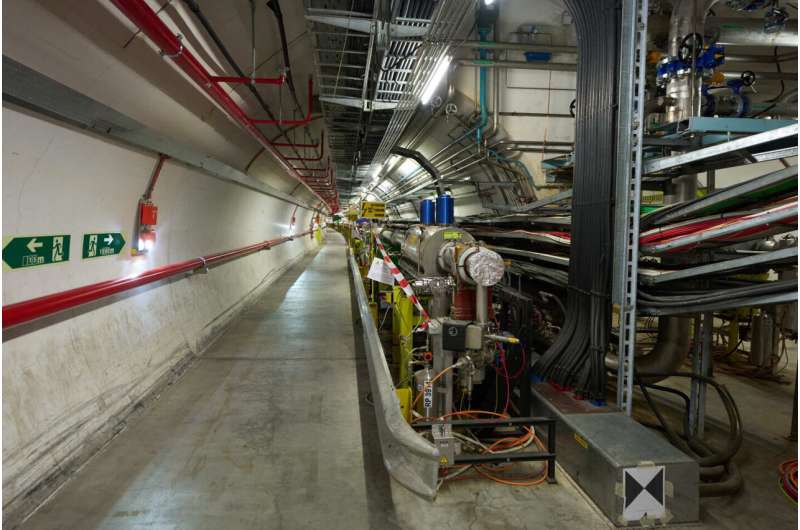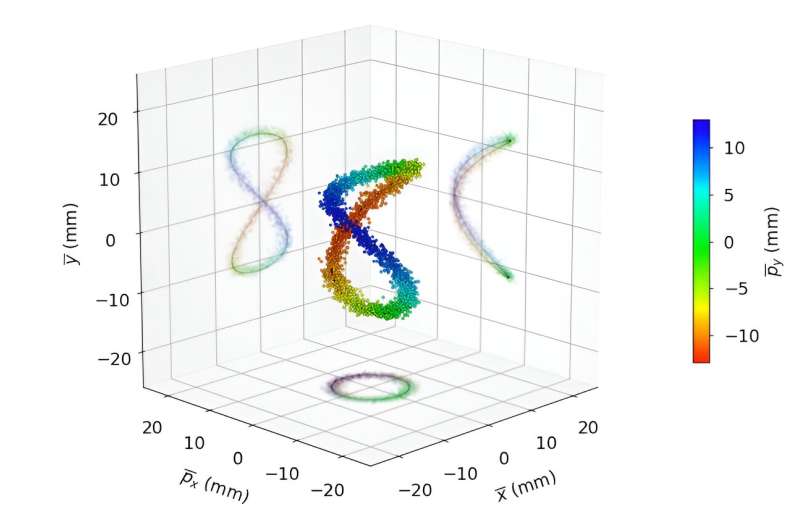This article has been reviewed according to Science X's editorial process and policies. Editors have highlighted the following attributes while ensuring the content's credibility:
fact-checked
trusted source
proofread
CERN measures coupled resonance structure that may cause particle loss in accelerators for the first time

Whether in listening to music or pushing a swing in the playground, we are all familiar with resonances and how they amplify an effect—a sound or a movement, for example. However, in high-intensity circular particle accelerators, resonances can be an inconvenience, causing particles to fly off their course and resulting in beam loss. Predicting how resonances and non-linear phenomena affect particle beams requires some very complex dynamics to be disentangled.
For the first time, scientists at the Super Proton Synchrotron (SPS), in collaboration with scientists at GSI in Darmstadt, have been able to experimentally prove the existence of a particular resonance structure. While it had previously been theorized and appeared in simulations, this structure is very difficult to study experimentally as it affects particles in a four-dimensional space.
These latest results, published in Nature Physics, will help to improve the beam quality for low-energy and high-brightness beams for the LHC injectors at CERN and the SIS18/SIS100 facility at GSI, as well as for high-energy beams with large luminosity, such as the LHC and future high-energy colliders.
"With these resonances, what happens is that particles don't follow exactly the path we want and then fly away and get lost," says Giuliano Franchetti, a scientist at GSI and one of the paper's authors. "This causes beam degradation and makes it difficult to reach the required beam parameters."
The idea to look for the cause of this emerged in 2002, when scientists at GSI and CERN realized that particle losses increased as accelerators pushed for higher beam intensity. "The collaboration came from the need to understand what was limiting these machines so that we could deliver the beam performance and intensity needed for the future," says Hannes Bartosik, a scientist at CERN and another of the paper's authors.
Over many years, theories and simulations were developed to understand how resonances affected particle motion in high-intensity beams. "It required an enormous simulation effort by large accelerator teams to understand the effect of the resonances on beam stability," says Frank Schmidt at CERN, also one of the paper's authors. The simulations showed that resonance structures induced by coupling in two degrees of freedom are one of the main causes of beam degradation.
It took a long time to devise how to look for these resonance structures experimentally. This is because they are four dimensional and require the beam to be measured in both the horizontal and the vertical planes to see if they exist. "In accelerator physics, the thinking is often in only one plane," adds Franchetti.
To measure how resonances affect particle motion, the scientists used beam position monitors around the SPS. Over approximately 3,000 beam passages, the monitors measured whether the particles in the beam were centered or more to one side, in both the horizontal and vertical planes. The resonance structure that was found is shown in the figure below.

"What makes our recent finding so special is that it shows how individual particles behave in a coupled resonance," continues Bartosik. "We can demonstrate that the experimental findings agree with what had been predicted based on theory and simulation."
While the existence of the coupled resonance structures has now been observed experimentally, much more remains to be done to reduce their detrimental effect. "We're developing a theory to describe how particles move in the presence of these resonances," continues Franchetti. "With this study, coupled with all the previous ones, we hope we will get clues on how to avoid or minimize the effects of these resonances for current and future accelerators."
More information: H. Bartosik et al, Observation of fixed lines induced by a nonlinear resonance in the CERN Super Proton Synchrotron, Nature Physics (2024). DOI: 10.1038/s41567-023-02338-3
Provided by CERN





















